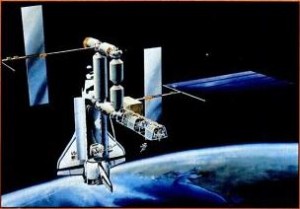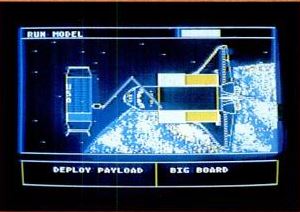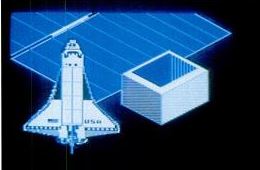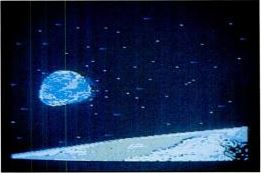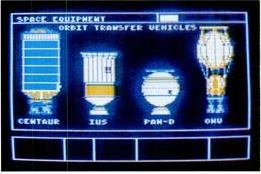As long as there has been a space program, there have been space-program boosters. With budgets dwindling and interest waning after Apollo 11, however, NASA suddenly needed them as never before. Various people started various organizations to educate, to advocate, to lobby, sometimes even to agitate the case for space. Briefly among the more prominent of these folks during the early 1980s was Stan Kent, a precocious English rocket scientist still in his mid-twenties.
Growing up working class in the industrial city of Wolverhampton in the West Midlands, Kent wrote to NASA asking for more information about the Titan rocket used to hoist the Gemini space capsules into orbit. Much to his family’s surprise, they sent it, cementing a passionate love affair with space and with NASA. (NASA was notably wonderful about this sort of thing in their 1960s heyday; many a starry-eyed kid all over the world received a similar thick envelope filled with pictures and articles for no charge but the cost to mail a letter to Houston.) At age 15, he demonstrated for the first time what would prove to be a lifelong knack for self-promotion. Determined to find a way to study rocket science, he entered a contest to design a functioning powered aircraft which won him national attention inside his home country and was enough to recommend him to a wealthy philanthropist in Santa Clara, California, named Austen Warburton. With Warburton’s assistance, he came to the United States to attend university at the age of 17, and graduated from Stanford with a Masters in aerospace engineering in 1978 at the age of 22, winning the prestigious Herman Oberth Gold Medal in the process for his paper on “The Space Shuttle External Tank as a Reentry Module.” He was soon working for Boeing and later Lockheed, and doing consulting jobs for NASA itself.
Kent’s public space advocacy began in 1979, when he got wind of proposals within NASA to stop monitoring the two Viking probes that had landed on Mars three years before simply because they couldn’t afford to continue to pay people to do it. He organized a Viking “charity” which presented NASA administrator Robert A. Frosch with a check for $60,000 to go toward continued monitoring on January 7, 1981. The sum would increase to over $100,000 in the months to come, then increase dramatically again when he organized with former astronaut and Moon-walker Pete Conrad to sell off recovered pieces from the old Skylab space station by way of further fundraising. (By that time Viking 2 had already gone offline due to a failed battery. Viking 1 would continue to transmit — and, yes, to be monitored — until a botched software update took it offline on November 11, 1982.)
Under the aegis of Delta Vee, the nonprofit corporation he set up with the assistance of Warburton and some aerospace colleagues, Kent stumped the country on behalf of space, appearing on television, on radio, in Omni magazine (with whom he did much of his advocacy in partnership), and in countless newspaper articles. He worked to set up a nationwide network of “neighborhood space centers” — “the McDonald’s of space” — and gave speeches to anyone who would have him. Far from your stereotypical rocket scientist, Kent made space cool in what the L.A. Times described as his “new-wave haircut, beige suit, purple shirt, and bright red tie”; he looked like “he might be a member of a rock band.” In September of 1981 he testified before the Congressional Subcommittee on Space Science and Applications at the age of just 25. His pitch emphasized a new, more pragmatic take on space very much in keeping with the dawning hyper-capitalism of the 1980s. The NASA that Kent described was fundamentally a practical enterprise whose work would bring scientific and technological breakthroughs to make life better for ordinary Americans, along with economic benefits to the country; Kent was fond of citing such dubious surveys as the one done in 1972 by Chase Econometrics, which claimed that every $1 spent on the space industry injected $10 to $15 back into the economy within five to seven years.
In that spirit, he and his partners soon set up a second, for-profit corporation they named AstroSpace. Its initial purpose was to research and hopefully to exploit a pet idea Kent called SOLARES: “Space Orbiting Light Augmentation Reflector Energy System,” a way to beam concentrated sunlight down to Earth for use as energy. In the meantime, though, the home-computer boom was happening. Soon Kent hit upon a more earthbound project for his company: to create a computer game that simulated the building and operation of the permanent space station that he and so many others felt represented the next logical steppingstone to Mars and beyond. By 1983 he had sold the idea to Jay Balakrishnan of Human Engineered Software, who loved big, high-concept edutainment titles.
Project: Space Station was certainly that. The game that Kent and Balakrishnan described (separately) to InfoWorld magazine in 1984 — it was quite obviously the HES product that the latter was most excited to discuss — filled nine disk sides. Balakrishnan:
It’s an absolute simulation. First of all, to start you have to go to Congress to requisition a budget. You have to choose your scientific team that will comprise the space mission. There’s a book, almost like a story, with different fictitious characters that you can select your team from. There’s a whole page of biographical data on each person — where they went to school, whom they married, whether they’re stable individuals or not, and so on. Then you must decide on what kind of industry you’re going to develop in space — for example, if you want to make ball bearings or crystals or whatever.
Then you design your space station. Each one is a different module. You might build a plant area, living quarters, etc. Then you run a simulation. Now the plant starts working, giving oxygen and life, and the industry starts working. You see that it’s a viable operation. Finally, after you have overseen everything, you resign your post. You were the director of a successful space industry, so you get your gold watch at the end. Of course, during the game all kinds of random things can occur. Maybe you’ve gone over budget. So you go back to Washington, D.C., and appeal for a higher requisition to keep the business going.
Together Kent and Balakrishnan organized an “advisory” board for the project that consisted of Kent’s colleagues in the aerospace industry along with the high-school students who would be the game’s most obvious target market, all “overseen” by the hapless, computer-illiterate Leonard Nimoy (who must have been wondering by this point why he’d signed on with HES at all).
I find this original conception of Project: Space Station fascinating as an early example of a computer game with an explicit real-world rhetorical goal. One could call it without hyperbole propaganda, a political advertisement for a NASA space station. The justifications it makes for such a project are the same as those Kent was making in his speeches, and, indeed, those that Ronald Reagan more obliquely referred to in his State of the Union address of 1984. In Project: Space Station, players would enjoy success not so much in the form of exploratory firsts or pure scientific breakthroughs but rather that of crop surveys that would make American agriculture more efficient, new semiconductors that would make American computers more powerful, lasers that would revolutionize American manufacturing, even the proverbial cure for cancer. If it wasn’t always entirely clear why some of these research projects had to be done by people in space, well, that was a problem Project: Space Station shared with some of Kent’s speeches.
This huge game being developed by a bunch of aerospace people with no experience in game development was of course all but doomed to failure. Kent and company did manage to get far enough to produce some intriguing screenshots that, as published in the April 16, 1984, issue of InfoWorld, stand today as the only tangible artifacts left to us from this version of Project: Space Station. The whole thing collapsed by the end of that year, with HES going bankrupt and being absorbed by Avant-Garde Publishing and AstroSpace coming to an abrupt end along with Kent’s time as a space advocate. He made an extreme and kind of bizarre change in life direction, opening back in Santa Clara a night club called One Step Beyond that became a regular stop on the college-rock touring circuit for some years. Today he writes erotica, hosts naughty events at a sex shop, and is something of a fixture of the Southern California nightlife scene while apparently still keeping his hand in from time to time as a rocket scientist. In 2012 he consulted on the perfect combination of all his interests: a proposed Playboy space station.
(Stan Kent’s space advocacy is chronicled in the August 3 1980 Washington Post, the January 8 1981 and November 12 1982 New York Times, and the July 22 1982 L.A. Times. The two InfoWorld articles that describe Kent’s original vision for Project: Space Station are in the April 16 1984 and September 3 1984 issues. A transcript of his testimony before Congress is contained in the government publication “Future Space Programs, 1981: Hearings Before the Subcommittee on Space Science and Applications of the Committee on Science and Technology, U.S. House of Representatives, Ninety-seventh Congress, First Session, September, 21, 22, 23, 1981.” The space-advocacy movement of the late 1970s and early 1980s and the place of a space station within are treated at length in Reaching for the High Frontier by Michael A. G. Michaud, available online from The National Space Society.)
